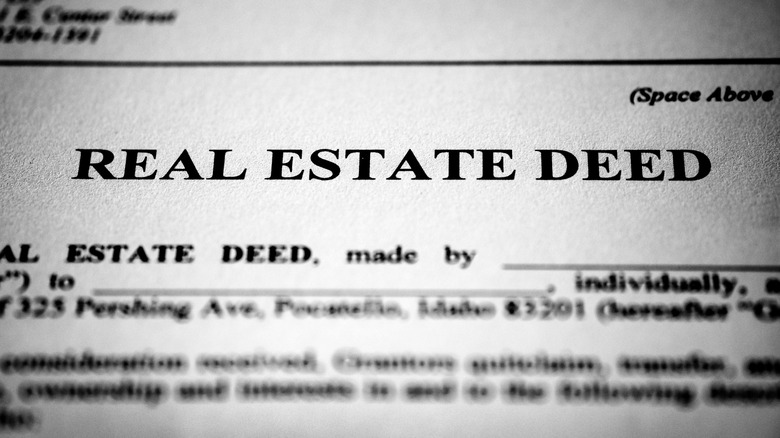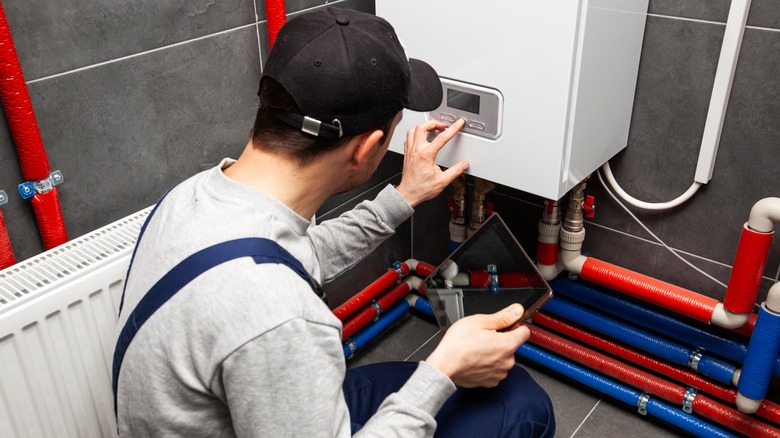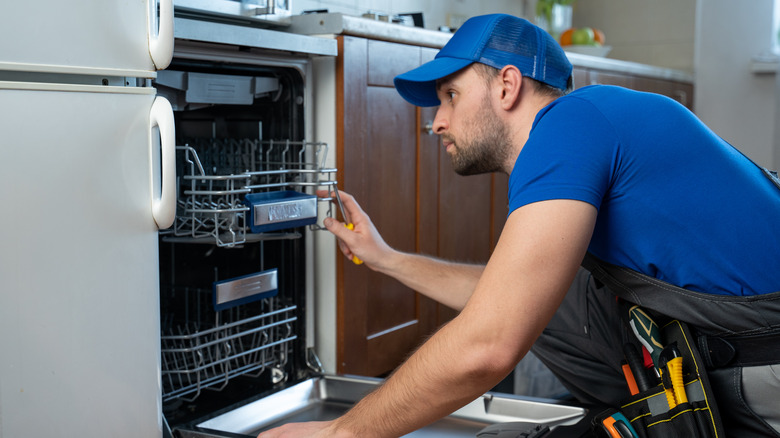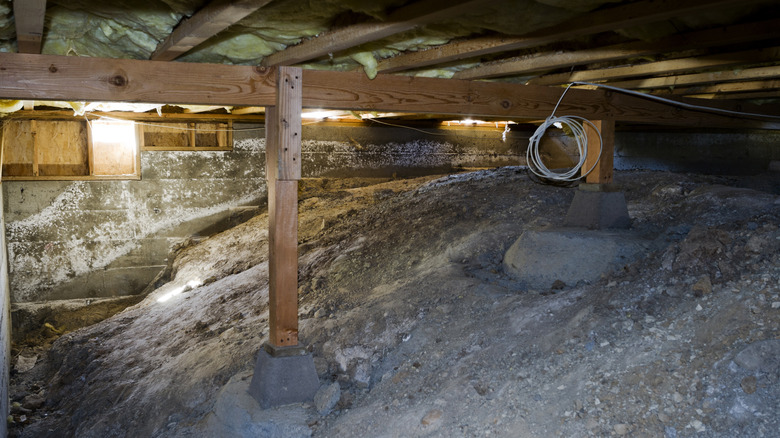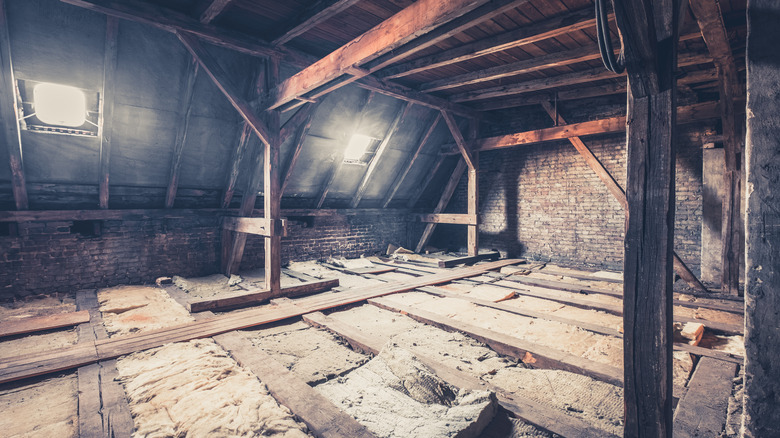Red Flags To Look Out For When Buying A Flipped House
In the first quarter of 2023, 9 percent of all home sales were classified as flipped houses, according to New Silver. A flipped house might be an excellent choice for a home buyer, and some flippers produce high-quality renovations. On the other hand, a number of potential pitfalls can occur when a flipper buys a home and renovates it as cheaply as possible, aiming for a quick resale. With the need to turn a profit, the investor might reduce overhead costs by using cheap materials and hiring unqualified contractors and laborers who will work for low wages with shoddy results.
Flipped homes are often older dwellings that may harbor structural and systematic damage due to years of neglect. Add to that the possibility that there may be hidden difficulties with ensuring a clear pathway to legal ownership as well as problems with building permits and code compliance. When potential home buyers consider flipped houses, it's imperative that they do their research and due diligence regarding multiple aspects of the deal. In the process, it's wise to watch out for a number of red flags.
A municipal inspection reveals problems with permits and code violations
The general contractor and subcontractors who perform the work on a home renovation are required to take out permits. These are issued by the local government agency in charge of infrastructure and development. After the job is done, a municipal inspector (sometimes called a city inspector) ensures that the work was completed properly and that legal permits were issued for all aspects of the renovation. In this process, the inspector pulls files from the government agency and makes an in-person assessment of the work and the property. The inspector's job is to ensure that the renovation work meets local codes for zoning, safety, and structural integrity, as well as systems such as electrical, heating and air conditioning, plumbing, and fuel gas systems.
If the seller does not provide documentation of a municipal inspection, the buyer can commission one from the local government. If the process fails to show that permits and code compliance are in order, it's a red flag for the potential buyer. A failed municipal inspection signals inferior workmanship and the potential for costly repairs down the road. In fact, it may be illegal to transfer the title and occupy the home if the renovations do not comply with building codes.
The general contractor or subcontractors are not licensed
General contractors as well as subcontractors for electrical, plumbing, and heating/air conditioning systems must often be licensed by the state in which they operate. You can learn about any licensing requirements for your state by searching the state government website. If you're considering buying a flipped house, you should ask to see the licenses of the contractors responsible for the renovation work. Then, you can verify the authenticity of the contractor's and subcontractors' licenses by searching on your state government's website.
In some states, the Secretary of State's website offers a licensing section. Here, you can type in a name and check to see if that person is legally licensed to perform the work. In other states, the process for verifying a contractor's license may be under the state government's Department of Consumer Affairs. In either case, the records of licensure are available to the public.
When you cannot verify that the renovation work was performed by licensed contractors, it's a major red flag for a flipped house. Failure to secure a license indicates that the contractor is inexperienced and was likely unqualified to do the work. They may have failed to perform steps that ensure the quality and durability of the renovations as well as the safety of future occupants.
The title search reveals problems with clear ownership of the property
When you're preparing to purchase a house, you'll need to have a title search done. Property deeds are available to the public at your county courthouse or county assessor's office, and you can view the documents without cost. However legal documents can be confusing for nonprofessionals to understand. That's why the search is typically performed by a lawyer or a title company. A clear title allows you to take legal possession of the property, free from entanglements with others who might claim ownership or rights of usage.
House flippers often buy old, run-down houses and hold them for a brief time while the remodeling work is done before putting them back on the market. In the rush to resell the property and make a profit, the flipper might not have obtained a clear property title that spells out unencumbered ownership. There may be liens or judgments for unpaid taxes, prior ownership claims, property easements, and other complications that impede the legal transfer of ownership to a new buyer. If you cannot confirm a clear title for the property, it's a sure sign that you should walk away from the potential home purchase.
A home inspector finds problems with major systems and structures in the house
Before buying any home, you'll want to hire a licensed inspector who will take a close look at the entire structure as well as all of the functioning systems. This step takes on even greater importance when you're considering a flipped house that has been renovated for resale. The home inspector that you hire is different from a municipal inspector who checks building permits and code compliance.
This expert will go through an extensive, itemized checklist that provides an overall picture of the home's condition. They will investigate the structural integrity of the house from the foundation to the roof, looking for rot and mold as well as damaged and worn-out materials. Additionally, the inspector will examine the functioning systems that make a home livable. These include the drainage and septic systems as well as the plumbing, electrical, heating, ventilation, and air conditioning (HVAC) systems. Inspectors assess the conditions of appliances like dishwashers and stoves as well as safety features like smoke detectors and stairway railings.
After completing the inspection, the professional home inspector will answer questions and give a report to the prospective buyer. With that information, you'll know where crucial repairs are necessary. If you see major problems that require costly remediation efforts, it's a huge red flag. At that point, you might choose to walk away from the purchase, or you'll have the necessary knowledge to proceed with continued renovation work.
The seller's disclosure does not contain complete information about the renovations
State and federal laws require sellers to disclose important information about their properties so that potential buyers can make informed decisions about their purchases. The seller's disclosure should detail any structural defects and system faults in the home. Additionally, natural hazards and neighborhood nuisances should be revealed. A list of all repairs and renovations should be included in the disclosure, and this section of the document is particularly important for a flipped house.
After reading the seller's disclosure, you'll want to take an in-person house tour where you'll look for evidence of the defects, faults, repairs, and renovations listed. Additionally, you should assess other aspects of the home's condition. For example, check to see if electrical switches, outlets, and HVAC systems are working.
If you notice that the seller's disclosure does not line up with your personal inspection of the home, it's a red flag. A seller who does not prepare a complete and honest disclosure document may be a flipper who is hiding sloppy work and inattention to detail. In this case, the flipped house may look nice on the surface while harboring major problems that could require costly repairs in the future.
You notice shoddy workmanship throughout the home
When you're walking through a flipped house, it's a good idea to observe the workmanship for fixes and renovations with an eye for detail. Maybe you notice paint drips, loose molding, and sloppy caulking. Those signs of shoddy workmanship may signal greater problems that you don't see at first glance. The flipper may have hired unqualified and unlicensed subcontractors, and the work may have been accomplished as fast and cheaply as possible to turn a quick profit.
You might need to look below the surface. For example, an electrical outlet may not be working, and when you remove the wall plate, you find that it was not wired properly. In fact, some examples of shoddy workmanship could lead to unsafe conditions such as an electrical junction box hidden behind drywall or a piece of decorative molding nailed over a rotting support beam. While a crooked cabinet or a gap in the bathroom tiles might seem like a minor problem, those faults are warning signals that things are not right. Serious issues may lie beneath the surface, and then the buyer inherits the responsibility for the costly repairs.
New fixtures and finishes are cheaply made
One of the attractive aspects of flipped houses is that they are move-in ready with all-new fixtures. These include faucets and handles, shower nozzles, lighting fixtures, ceiling fans, towel racks, countertops, bathroom tile, and more. Typically, everything looks shiny and new in a flipped house.
However, the flipper is in the business to make money, and cutting corners on expensive fixtures may be a viable way to reduce overhead. In the process of renovating the property, the investor may have selected the cheapest available version of every fixture and finish. When they're new, cheap fixtures can look as nice as the more expensive options. The difference lies in the durability of the fixture or finish. It's often worth spending a bit more to buy a higher-quality fixture that will last longer. Many middle-of-the-line options provide aesthetic details along with durable service. But it's wise to be wary of a flipped house that has only the cheapest fixtures and finishes. The home buyer will be stuck with the replacement costs and hassle when the cheap fixtures and finishes wear out quickly.
Appliances aren't properly installed
Buyers may be delighted to see the new appliances in flipped houses, including stoves, refrigerators, dishwashers, and more. Especially in the promotional photographs, a kitchen renovation with new appliances looks fresh and appealing. But keep in mind that the appliances must be installed correctly by professional plumbers and electricians to ensure that they work properly and meet code requirements. Be aware that the flipper might have saved money on renovation costs by failing to hire professionals to do the work, resulting in improperly installed home appliances.
The professional home inspector that you hire should check to determine that all appliances are installed correctly. If not, they will inform you of the fixes that should be made. For example, the faulty installation of a dishwasher can lead to water leaks beneath the appliance and the sink as well as damage to the water and drain lines. On the surface, the new dishwasher looks great, and the unwary buyer may not observe the problems. But if you find incorrectly installed appliances in the home, it's a huge red flag that the renovations were done without attention to detail and proper procedures.
Newly installed carpet covers uneven floors or buckling floorboards
New carpet looks clean and fresh, and it lends a cozy feeling to a home environment. However, a flipper can use new, wall-to-wall carpet to mask flooring conditions that indicate serious structural problems. Over time, these problems may require expensive corrective measures, leaving the unwary buyer with the responsibility for expensive fixes. If you're considering the purchase of a flipped house, it's important to notice how the floors feel when you walk across them.
If the floors sag in some places or if they slope from one wall to the other, it's a sign of serious problems with the structure of the house. Additionally, loose or buckling floorboards may signal problems with the home's foundation. Movement of the soil or excess moisture and rot may have compromised the home's underlying structure and joists that provide support for the building. Sagging or uneven floors that are covered by new carpet send up a giant red flag for potential home buyers. The cost for structural repairs to a home's foundation may run up into thousands of dollars.
There isn't access to the attic
A potential buyer and their home inspector should be able to investigate the condition of all areas of a house. This includes the attic above the living spaces as well as the crawl space or basement down below. These areas typically house the ductwork, electrical wiring, insulation, HVAC systems, and other important operational equipment for the home. In some flipped houses, the flipper purposefully seals off access to the attic or other out-of-the-way areas. Their hope is that a potential buyer will be dazzled by the surface appearance of the renovated rooms and fail to inspect the inner workings of the house.
When you're taking a tour of a flipped house, be sure that your inspection includes the attic and the basement or crawl space. If you find that the entries have been boarded up or blocked, it's a huge red flag that the flipper is trying to hide something. The important structural and functional components of the home may be damaged, broken, or simply worn out from age. Perhaps the flipper failed to invest the time and money to complete the necessary repairs and replacements. For example, a blocked entryway to the attack may be a sign that the flipper does not want you to see the crumbling condition of the roof.
Layouts are not convenient
Flippers typically do not live in their flipped homes, and they may overlook inconvenient room layouts in the rush to complete the renovations as quickly and cheaply as possible. When you're walking through a flipped house, take note of difficulties such as a door that won't open without bumping into another door or a drawer that won't open because it's blocked by a cabinet. These awkward layouts can become real nuisances for someone who tries to live and function in the home on a daily basis. They may require remediation in the future, resulting in expensive remodeling projects.
The kitchen is a place where flipped homes sometimes fail to meet expectations for convenient layouts. For example, the most convenient kitchen layout involves placing the cooking zone, the washing zone, and the food-prep zone in a triangle-shaped area, along two or three walls. This layout allows the cook to move quickly and easily between the three work zones, maintaining a smooth flow of activities.
As an inexpensive alternative, flippers might place the three work zones linearly, straight along a wall. This allows them to install the wiring and plumbing in only one wall, saving time and money. However, they neglect to consider how the arrangement might work in real life. Although the new appliances and fixtures may present an attractive surface appearance, a one-wall kitchen layout is not convenient for everyday living. It's an awkward layout that becomes a red flag for a potential buyer.



